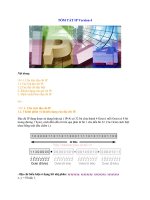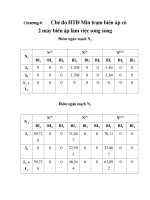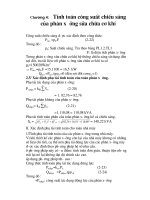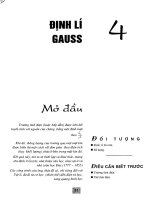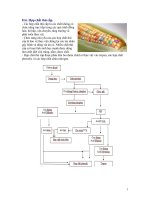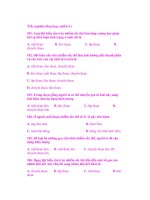Dimension TM 3100 Manual Version 4.43B phần 4 pps
Bạn đang xem bản rút gọn của tài liệu. Xem và tải ngay bản đầy đủ của tài liệu tại đây (127.12 KB, 2 trang )
Cantilever Preparation
6-8 Dimension 3100 Manual Rev. B
Tip Shape of Etched Silicon Probes continued
Measurements of line pitch are often best measured using the side-to-side
faces of the tip, which exhibits symmetry. Because of the approximate 17°
half angle of the tip, the line or space measurement is best done at the top of
the line for simplification of the measurement artifacts (See Figure 6.2e).
Figure 6.2e Common Silicon Probe Profile (Resultant Scan Artifact)
Figure 6.2e depicts the resultant effect of the angled back ridge on the step
angle measurement for a deeper trench depth. This is tip and topography
dependent.
In addition to microscopic scale shape characteristics (See Figure 6.2b-
Figure 6.2e), another factor which can affect the wall angle over shorter
(nominal 100 nm) step height measurements is the shaped cusp at the end of
the tip. The shaped cusp at the end of the tip is formed to increase the
sharpness of the tip point to a length of 100 nm from the end of the tip. It is
formed in such a manner that the radius of curvature of a silicon tip can be in
the range of 5–10 nm (on a very good tip).
S
can Line Profile
55°
70 - 80°
10°
1 µm - 2 µm Deep Trench
Note: Any wall angle on the left wall that is > 55 deg.
will be shown as 55 deg. in the image.
Any wall angle on the right wall that is >70-80 deg.
will be shown as 70 -> 80 deg. in the image.
Subsequent scan line produced
using the realistic tip shape
Cantilever Preparation
6-8 Dimension 3100 Manual Rev. B
Tip Shape of Etched Silicon Probes continued
Measurements of line pitch are often best measured using the side-to-side
faces of the tip, which exhibits symmetry. Because of the approximate 17°
half angle of the tip, the line or space measurement is best done at the top of
the line for simplification of the measurement artifacts (See Figure 6.2e).
Figure 6.2e Common Silicon Probe Profile (Resultant Scan Artifact)
Figure 6.2e depicts the resultant effect of the angled back ridge on the step
angle measurement for a deeper trench depth. This is tip and topography
dependent.
In addition to microscopic scale shape characteristics (See Figure 6.2b-
Figure 6.2e), another factor which can affect the wall angle over shorter
(nominal 100 nm) step height measurements is the shaped cusp at the end of
the tip. The shaped cusp at the end of the tip is formed to increase the
sharpness of the tip point to a length of 100 nm from the end of the tip. It is
formed in such a manner that the radius of curvature of a silicon tip can be in
the range of 5–10 nm (on a very good tip).
S
can Line Profile
55°
70 - 80°
10°
1 µm - 2 µm Deep Trench
Note: Any wall angle on the left wall that is > 55 deg.
will be shown as 55 deg. in the image.
Any wall angle on the right wall that is >70-80 deg.
will be shown as 70 -> 80 deg. in the image.
Subsequent scan line produced
using the realistic tip shape
